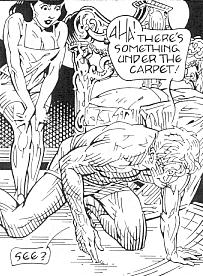Legend: A mysterious bolt in a bedroom floor turns out to be holding up the chandelier in the room below.
Examples:
[Collected on the Internet, 1998] There was a family, two sisters and their parents, who were living happily at an apartment in Chicago (near Lake Shore Drive). The parents, being kind and generous, almost always let them do whatever they wanted (as long as it wasn't drugs or anything like that). The one thing they couldn't do was touch this nail sticking out of their parents' lavishly furnished bedroom floor, but they never told them why. One morning, after waking up in the living room (they stayed up late watching old horror flicks), they went into their parents' bedroom and found told her sister what she had concluded, they decided to take a better look at the nail. That night they went into the bedroom and just stood next to the nail, staring at it for a few minutes. The older sister said that since she had come up with the idea, the younger one should be the first one to touch it. Being the braver one, she bent down and tapped it. Nothing happened. This time, she tapped it even harder. Nothing happened. By this time, the older one touched it too, trying to hide that she was scared. But the younger sister wasn't satisfied yet. She went into a closet and brought out a hammer, and pulled the nail out. Then suddenly, CRASH!!! They didn't know where the sound came from exactly, but it was enough to scare them. They ran into their bedroom and slammed the door. A few minutes passed and they heard a loud knock on their door. They slowly stepped out of their room and to the apartment door. They opened the door, and one of their neighbors (the one that lived below them) was standing in front of them, but the thing was, he was cut everywhere and his clothes were stained red. The younger one asked, [Train, 1996] Before several colleagues and I set off for Russia to attend a medical meeting, we were warned to be careful of what we said in our hotel rooms — they might be bugged. So as soon as my medic roommate and I arrived, in true James Bond fashion we began a systematic room search for any electronic intruder. We immediately noticed a suspicious bump in the rug. We turned it back to reveal the end of a metal pipe, about two inches in diameter, sealed with a plastic cup. Removing the cup, we found a large nut screwed down on several insulated wires. To deactivate the device, we unscrewed the nut. This was quickly followed by a loud crash in the room below, whose chandelier we'd just unfastened. [Cerf, 1965] Caskie Stinnett reports that a passel of French delegates to a Moscow trade fair, understandably alert to the possibilities of their hotel room being bugged, cut through a maze of multi-colored wires they discovered cleverly hidden under the carpet. The floor was thick, but not so thick that it deadened the sound of the chandelier crashing in the room beneath them. |
Origins: Prior to the "nosy daughters" version quoted above, this tale circulated in two main forms. In one, newlyweds fearing someone had bugged the bridal suite as a prank

unscrew a suspicious-looking bolt in the floor. Only the next morning do they discover their action sent a light fixture crashing down onto a couple in bed in the room below or a massive chandelier to its thousand-piece demise on the marble floor of the hotel lobby.
An equally popular version about diplomats on a mission to Moscow is also in circulation. A search of their hotel room reveals to the travellers the presence of a large knob clumsily hidden under a rug. The clever trade delegates remove it, then toss what they presume to be a microphone out a window, congratulating themselves on having foiled their eavesdroppers. Moments later, the KGB is pounding on their door, but not to replace the "bug." No, it seems the visitors caused a large chandelier to come crashing down onto the dancers in the hotel's ballroom.
One telling attributes the Russian incident to hockey star Phil Esposito, placing it during a leg of the 1972 Canada-Russia series when Team Canada was in Moscow. This version, however, surfaces in 1985 and 1996 books, so we don't know if it was told in 1972 or is just now being told about 1972. What is known, however, is the same story (minus Esposito) surfaced in a 1965 joke book, and as an anecdote told by Admiral of the Fleet
Barbara "truth Orr dare" Mikkelson
Last updated: 27 December 2004
 Sources:
Sources:
 Also told in:
Also told in:Healey, Phil and Rick Glanvill. Now! That's What I Call Urban Myths. London: Virgin Books, 1996. ISBN 0-86369-969-3 (pp. 237-238). Petras, Ross and Kathryn Ross. The 176 Stupidest Things Ever Done. New York: Doubleday, 1996. ISBN 0-385-48341-4 (p. 126). The Big Book of Urban Legends. New York: Paradox Press, 1994. ISBN 1-56389-165-4 (p. 184).
